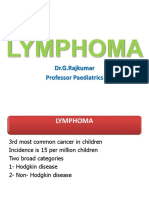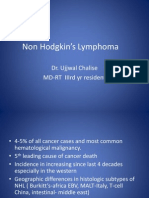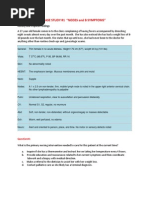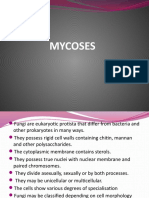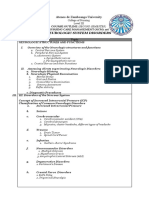0 ratings0% found this document useful (0 votes)
9 viewsMedicine Seminar Combined-1
Medicine Seminar Combined-1
Uploaded by
Deepanshu KumarLymphomas are malignant neoplasms originating in the lymphatic structures and bone marrow resulting in lymphocyte proliferation. Hodgkin's lymphoma is characterized by Reed-Sternberg cells and is classified into classical and non-classical subtypes based on histology. Non-Hodgkin's lymphoma represents a monoclonal proliferation of B or T cells and is stratified based on cell lineage, genetics, and grade which reflects proliferation rate. High grade NHL has high proliferation and is potentially curable with chemotherapy while low grade NHL has indolent progression but is often disseminated requiring targeted therapies or transplantation.
Copyright:
© All Rights Reserved
Available Formats
Download as PPTX, PDF, TXT or read online from Scribd
Medicine Seminar Combined-1
Medicine Seminar Combined-1
Uploaded by
Deepanshu Kumar0 ratings0% found this document useful (0 votes)
9 views30 pagesLymphomas are malignant neoplasms originating in the lymphatic structures and bone marrow resulting in lymphocyte proliferation. Hodgkin's lymphoma is characterized by Reed-Sternberg cells and is classified into classical and non-classical subtypes based on histology. Non-Hodgkin's lymphoma represents a monoclonal proliferation of B or T cells and is stratified based on cell lineage, genetics, and grade which reflects proliferation rate. High grade NHL has high proliferation and is potentially curable with chemotherapy while low grade NHL has indolent progression but is often disseminated requiring targeted therapies or transplantation.
Copyright
© © All Rights Reserved
Available Formats
PPTX, PDF, TXT or read online from Scribd
Share this document
Did you find this document useful?
Is this content inappropriate?
Lymphomas are malignant neoplasms originating in the lymphatic structures and bone marrow resulting in lymphocyte proliferation. Hodgkin's lymphoma is characterized by Reed-Sternberg cells and is classified into classical and non-classical subtypes based on histology. Non-Hodgkin's lymphoma represents a monoclonal proliferation of B or T cells and is stratified based on cell lineage, genetics, and grade which reflects proliferation rate. High grade NHL has high proliferation and is potentially curable with chemotherapy while low grade NHL has indolent progression but is often disseminated requiring targeted therapies or transplantation.
Copyright:
© All Rights Reserved
Available Formats
Download as PPTX, PDF, TXT or read online from Scribd
Download as pptx, pdf, or txt
0 ratings0% found this document useful (0 votes)
9 views30 pagesMedicine Seminar Combined-1
Medicine Seminar Combined-1
Uploaded by
Deepanshu KumarLymphomas are malignant neoplasms originating in the lymphatic structures and bone marrow resulting in lymphocyte proliferation. Hodgkin's lymphoma is characterized by Reed-Sternberg cells and is classified into classical and non-classical subtypes based on histology. Non-Hodgkin's lymphoma represents a monoclonal proliferation of B or T cells and is stratified based on cell lineage, genetics, and grade which reflects proliferation rate. High grade NHL has high proliferation and is potentially curable with chemotherapy while low grade NHL has indolent progression but is often disseminated requiring targeted therapies or transplantation.
Copyright:
© All Rights Reserved
Available Formats
Download as PPTX, PDF, TXT or read online from Scribd
Download as pptx, pdf, or txt
You are on page 1of 30
Lymph node malignancies
• Roll no- 1936, 1937
Lymphomas
- these are malignant neoplasms originating
into the bone marrow and lymphatic
structures resulting in the proliferation of the
lymphocytes .
Hodgkin’s lymphoma
Non-hodgkin’s lymphoma
Hodgkin lymphoma
Etiology
• Mostly idiopathic.
• Associated with EBV.
• HIV patients are at higher risk.
• Exposure to Benzene
• Males are affected more than female with 1.5:1
• Seen in 20-35 yrs of age and 50-70 yrs of age
• More common in the patients from well
educated backgrounds and small families.
Classical Reed sternberg cell
- histological hallmark of HL
- these are large malignant lymphoid cells of B
cell origin
- Present in small numbers but are surrounded
by large no. of reactive non malignant cells T
cells, plasma cells and eosinophils.
- shows Owl eye appearance
- CD15+ / CD30+ (markers of lymphocyte
activation)
Variants of Reed sternberg cells
1)Mononuclear cell-
with single large nucleus
2)Lacunar type-
single hyperlobated cell,
cytoplasm is retracted
around the nucleus creating
an empty space.
3)Pleomorphic RS cell
Multiple irregular nuclei
4)Lympho-histiocytic RS cell
small cell, with a very lobulated
nucleus, small nucleoli
Classification of HL
• Classical HL and Non classical HL
Classical HL involves :-
1) Nodular seclerosis
-most common subtype globally
-female and male are equally affected
-Seen in young adults
-Lacunar cells are seen and prognosis is good
2) Mixed cellularity
-Most common type in India
-seen in young adults and >55 yr of age
-RS cells plasma cells eosonophil mononuclear cells
3)Lymphocyte rich
-seen in elderly peopl
-mononuclear cells are seen in this variant
-prognosis is good
4) Lymphocyte depleted HL
-seen in elderly patients especially who are infected with
HIV.
-Atypical hodgkin’s cells are present .
-prognosis is worst.
Non classical variant:-
: -lymphocyte predominant HL
-CD15/CD30 (-) but CD20 (+)
-not associated with EBV
Clinical features
Patients most commonly present with
- painless rubbery lymphadenopathy in the
neck and supraclavicular fossae
- half of the patients develop spleenomegaly
during the course of the disease.
- liver enlargement too may occur.
constitutional symptoms like pel-ebstein fever
with night sweats and weight loss , fatigue
malaise and pruritus.
Ann arbor staging of hodgkin’s lymphoma
Stage l
I – involvement of a single lymph node region
IE- involvement of single extra lymphatic organ or site
Stage ll
II involvement of two or more lymph node regions on
the same side of the diaphragm
IIE with localised contigous involvement of an
extranodal organ or site.
• Stage III
III- involvement of lmphnode regions on the
both sides of the diaghragm
IIIE- with localised contiguous involvement of
an extranodal organ or site
IIIES-both the featues of IIIE and IIIES present
Stage IV
Multiple or disseminated involvement of one
or more extra lymphatic organs or tissues with
or without lymphatic involvement
INVESTIGATIONS
1)CBC may be normal. If a normochromic
normocytic anaemia or lymphopenia is
present, this is a poor diagnostic factor.
2)ESR may be raised
3)LFT may be abnormal reflecting the hepatic
infiltration .An obstructive pattern may be
caused by nodes at the porta hepatis
4)LDH are ussualy raised.
5)Chest X-ray may show a mediastinal mass.
6)CT scan of chest ,abdomen and pelvis for the
staging
7)Flowcytometery- CD15+and CD30+
8)Lymph node biopsy may be undertaken
surgically or by percutaneous needle biopsy
under radiological guidance.
9)Whole body PET scan for staging and follow up
TREATMENT
Treatment involves radiotherapy and chemotherapy
depending on the stage
drugs used – Adriamycin
Bleomycin
Vinblastine
Dacarbazine
For stage I and II
2-4 cycles of ABVD or Radiotherapy
Stage III and IV
6-8 cycles + radiation
• Make sure to monitor PFT and ECHO of the
patient as the bleomycin can cause pulmonary
fibrosis and doxorubicin can cause
cardiomyopathy
if the patient is resistant to the therapy –
autologous HSCT (hemopoietic stem cell
transplant)
Relapsed after chemotherapy or transplant -
Brentuximab which is monoclonal antibody
against CD30
Non Hodgkin lymphoma
Deepika
Roll no - 1937
• Non-Hodgkin
lymphoma (NHL)
represents a
monoclonal
proliferation of
lymphoid cells of B-
cell (90%) or T-cell
(10%) origin. The
incidence of these
tumours increases
with age, to
62.8/million population
per annum at age 75
years, and the overall
rate is increasing at
about 3% per year.
• Previous classifications were based principally on histological appearances.
The current WHO classification stratifies according to cell lineage (Tor B
cells) and incorporates clinical features, histology, genetic abnormalities and
concepts related to the biology of the lymphoma. Clinically, the most
important factor is grade, which is a reflection of proliferation rate.
• High-grade NHL has high proliferation rates, rapidly produces symptoms, is
fatal if untreated, but is potentially curable.
• Low-grade NHL has low proliferation rates, may be asymptomatic for many
months or even years before presentation, runs an indolent course, but is
frequently disseminated at diagnosis and not curable by conventional
therapy.
• Of all cases of NHL in the developed world, over 50% are either diffuse large
B-cell NHL (high-grade) or follicular NHL (low-grade).
• Other forms of NHL, including Burkitt lymphoma, mantle cell lymphoma,
mucosa-associated lymphoid tissue (MALT) lymphomas and T-cell lymphomas,
are individually less common.
Clinical features -
• Unlike Hodgkin lymphoma, NHL is often widely
disseminated at pres-entation, including in
extranodal sites. Patients present with lymph
node enlargement, which may be associated
with systemic upset:
• weight loss, sweats, fever and itching.
Hepatosplenomegaly may be present. Sites of
extranodal involvement include the bone
marrow, gut, thyroid, lung, skin, testis, brain
and, more rarely, bone. Bone marrow
involvement is more common in low-grade
(50%-60%) than high-grade (10%) disease.
• Other extranodal sites tend to be more
common in high grade diseases, particularly
CNS involvement. Compression symptoms may
Investigations -
• These are as for HL, but in addition the following
should be performed:
• Bone marrow aspiration and trephine to identify
bone marrow involvement.
• Immunophenotyping of surface antigens to
distinguish 7-cell from B-cell tumours. This may
be done on blood, marrow or nodal material.
• Cytogenetic analysis to detect chromosomal
translocations, particularly rearrangements of the
oncogene c-MYC and molecular testing for T-cell
receptor or immunoglobulin gene
rearrangements.
• Immunoglobulin determination. Some lymphomas
are associated with IgG or IgM paraproteins,
which serve as markers for treatment response.
• Measurement of urate levels.
Some very aggressive high-
grade
• NHLs are associated with very
high rate levels, which can
precipitate renal failure when
treatment is started as a
consequence of tumour lysis
syndrome.
• HIV testing. HIV is a risk factor
for some lymphomas and
affects treatment decisions.
• Hepatitis B and C testing. This
Management-
• Low-grade NHL-
• The majority of patients (80%) present with advanced
stage disease and will run a relapsing and remitting
course over several years. Overall survival has
improved in recent years with more treatment options.
• Asymptomatic patients may not require therapy and
are managed by "watching and waiting’.
• Indications for treatment include marked systemic
symptoms, lymphadenopathy causing discomfort or
disfigurement,bone marrow failure & compression
symptoms.
In follicular lymphoma the options are-
• Radiotherapy, this can be used for localised stage I
disease , which is rare. FDG PET-CT-confirmed stage I
disease has a 70% cure rate with radiotherapy.
• Chemotherapy. Most patients will respond to oral therapy
with chlor-ambucil, which is well tolerated, but not
curative and is reserved nowadays for older/trail patients.
More intensive intravenous chemotherapy in younger
patients produces better quality of life through long
periods of remission.
• Monoclonal antibody therapy. Humanised monoclonal
antibodies (biologic therapy’)can be used to target surface
antigens on tumour cells and to induce tumour cell
apoptosis directly. The anti-CD20 antibody rituximab, has
been shown to induce durable clinical responses in up to
60% of patients when given alone, and acts synergistically
when given with chemotherapy. Rituximab (R) in
combination with cyclophosphamide, vincristine and
prednisolone (R-CVP), cyclophosphamide, doxorubicin
• Targeted therapy. The PI3 kinase inhibitor
idealisib is approved for relapsed
follicular lymphoma and ibrutinib (Fig.
25.30) is approved for relapsed mantle
cell lymphoma (a poor-prognosis
lymphoma with low-grade histology, but
aggressive clinical behaviour) and for
relapsed Waldenstrom's
macroglobulinaemia (also known as lym-
Phoplasmacytic lymphoma.
• Transplantation. High-dose chemotherapy
and autologous HSCT
Can produce long remissions in patients
with relapsed disease.
Decisions on the timing of such
treatment are complex in the context of
rituximab maintenance and newer
targeted therapies.
However, younger patients with short first
High grade NHL-
• Patients with diffuse large B-cell NHL need
treatment at initial presentation:
• Chemotherapy. The majority (>90%) are
treated with intravenous combination
chemotherapy, typically with the CHOP
regimen (cyclophosphamide, doxorubicin
(hydroxydaunorubicin), vincristine (oncovin)
and prednisolone).
Monoclonal antibody therapy. When combined
with CHOP chemo-therapy, rituximab (R)
increases the complete response rates and
improves overall survival. R-CHOP, 4-6 cycles,
is currently recommended as first-line therapy
for all relatively fit patients. Dose reduction
(R-mini CHOP) is preferable in those over 80
years of age and replacement of doxorubicin
with gemcitibine (R-GCVP) is considered in
• Radiotherapy. Stage I patients without
bulky disease are treated with four cycles
of CHOP or R-CHOP, followed by involved
site radio-therapy. Radiotherapy is also
indicated for a residual localised site of
bulk disease after chemotherapy and for
spinal cord and other compression
syndromes.
• HSCT. Autologous HSCT benefits patients
with relapsed disease that is sensitive to
salvage immunochemotherapy. As with HL,
achieving a negative FDG PTC-CT negativity
to autologous transplantation is desirable.
• CAR-T-cell therapy- is licensed for
certain patients with multiply
relapsed DBL or high-grade
transformation of follicular Imphoma
and can salvage patients from a
desparate situation.
Prognosis -
• Low-grade NHL runs an indolent remitting and
relapsing course, with an overall median
survival of 12 years. Transformation to a high-
grade NHL occurs in 3% per annum and is
associated with poor survival.
• In diffuse large B-cell NHL treated with R-CHOP,
some 75% of patients overall respond initially to
therapy and 50% will have disease-free survival
at 5 years. The prognosis for patients with high
grade NHL is further refined according to the
international prognostic index (IPI). For high-
grade NHL, 5-year survival ranges from over
75% in those with low-risk scores (age <60
years, stage I or lI, one or fewer extranodal
sites, normal LDH and good performance status)
to 25% in those with high-risk scores
• Rearrangements of the c-MYC oncogene,
either alone (more commonly Burkitt
lymphoma) or with rearrangements of BCL-
2 and/or BCL-6 (double or triple hit high-
grade lymphomas) are recognised entities
in WHO classification with poor prognoses
and are increasingly treated more
aggressively.
• Relapse is associated with a poor
response to further chemotherapy (<10%
5-year survival), but in patients under 65
years HSCT improves survival.
Thank you !
You might also like
- FSM Haccp Butter ChickenDocument26 pagesFSM Haccp Butter ChickenAYMAN ZEHRANo ratings yet
- Is.3786 2022Document18 pagesIs.3786 2022hamidNo ratings yet
- Lymphoma in ChildrenDocument42 pagesLymphoma in ChildrenPriyaNo ratings yet
- Acute Myeloid LekumiaDocument34 pagesAcute Myeloid LekumiaBhuwan ThapaNo ratings yet
- غير معروف Lymphomas-10 (Muhadharaty)Document72 pagesغير معروف Lymphomas-10 (Muhadharaty)aliabumrfghNo ratings yet
- L3 Haematological MalignanciesDocument37 pagesL3 Haematological Malignanciesphylliswambua661No ratings yet
- Hodgkin Disease: Section 4Document53 pagesHodgkin Disease: Section 4habeba yasserNo ratings yet
- Lymphoma Shofik EDITED BY SAYAM 8.53PMDocument35 pagesLymphoma Shofik EDITED BY SAYAM 8.53PMRAGHU NATH KARMAKERNo ratings yet
- Basic - Hodgkin Limfoma - 221208 - 111343 2Document98 pagesBasic - Hodgkin Limfoma - 221208 - 111343 2Resta SeptiaNo ratings yet
- LymphomaDocument69 pagesLymphomaDawit g/kidanNo ratings yet
- Hodgkin's LymphomaDocument21 pagesHodgkin's LymphomaRavi K N100% (1)
- Malignancy DR RashaDocument29 pagesMalignancy DR RashaRasha TelebNo ratings yet
- Chronic Lymphocytic LeukemiaDocument43 pagesChronic Lymphocytic LeukemialaibaNo ratings yet
- LymphomasDocument34 pagesLymphomasanimesh vaidyaNo ratings yet
- Disorders of White Blood Cells and Lymphoid TissuesDocument30 pagesDisorders of White Blood Cells and Lymphoid Tissuesammar amerNo ratings yet
- LymphomaDocument18 pagesLymphomaAli HamzaNo ratings yet
- Lecture 14Document35 pagesLecture 14Zainab Noor ShahidNo ratings yet
- Conditions of The Lymph SystemDocument37 pagesConditions of The Lymph Systemkurage_07100% (1)
- Acute Leukemia: Thirunavukkarasu MurugappanDocument22 pagesAcute Leukemia: Thirunavukkarasu MurugappanFelix Allen100% (1)
- LymphomaDocument31 pagesLymphomaEbaNo ratings yet
- Lymphoid Lekemia: DR Budi Enoch SPPDDocument32 pagesLymphoid Lekemia: DR Budi Enoch SPPDLia pramitaNo ratings yet
- Lympho Gran Ulo Matos IsDocument22 pagesLympho Gran Ulo Matos IsBurhan NabiNo ratings yet
- LymphomaDocument53 pagesLymphomaRobert ChristevenNo ratings yet
- Lymphoma in Children: DR Sunil JondhaleDocument42 pagesLymphoma in Children: DR Sunil JondhaleSunjon JondhleNo ratings yet
- Blockxiv Neoplasms Lymphoid 2006Document54 pagesBlockxiv Neoplasms Lymphoid 2006Ryo RyozNo ratings yet
- Lymphoproliferative Diseases PDFDocument83 pagesLymphoproliferative Diseases PDFsiragebulugma970No ratings yet
- Advances in Management of NHLDocument34 pagesAdvances in Management of NHLMohammed Abd ElfattahNo ratings yet
- Lymphomas: Dr. Y.A. AdelabuDocument28 pagesLymphomas: Dr. Y.A. Adelabuadamu mohammadNo ratings yet
- Solid TumorsDocument69 pagesSolid TumorsserubimNo ratings yet
- Non Hodgkin'S Lymphoma: Dr. Ujjwal Chalise MD-RT Iiird Yr ResidentDocument56 pagesNon Hodgkin'S Lymphoma: Dr. Ujjwal Chalise MD-RT Iiird Yr ResidentUjjwal ChaliseNo ratings yet
- BY: Moses Kazevu (BSC Human Biology)Document40 pagesBY: Moses Kazevu (BSC Human Biology)Moses Jr KazevuNo ratings yet
- Hodgkin's LymphomaDocument106 pagesHodgkin's Lymphomawelly1962No ratings yet
- European Day of The Prevention of The Cardiovascular Risk by SlidesgoDocument76 pagesEuropean Day of The Prevention of The Cardiovascular Risk by Slidesgobinojdaniel17No ratings yet
- Non - Hodgkin LymphomaDocument25 pagesNon - Hodgkin LymphomaRo RyNo ratings yet
- Acute Myeloblastic Leukaemia: BY DR Halima Talba Consultant Haematologist Department of Haematology and BtsDocument44 pagesAcute Myeloblastic Leukaemia: BY DR Halima Talba Consultant Haematologist Department of Haematology and BtsMuhammad Modu BulamaNo ratings yet
- Childhood Malignancies - Hodgkin's LymphomaDocument6 pagesChildhood Malignancies - Hodgkin's Lymphomavictortayor_26105009No ratings yet
- DEN 24pediatric LymphomasDocument49 pagesDEN 24pediatric LymphomasKelvin chachaNo ratings yet
- 2 - Lymphoma Lecture by Dr. M T - PresentationDocument40 pages2 - Lymphoma Lecture by Dr. M T - Presentationsohilaw210No ratings yet
- Acute - LeukemiaDocument46 pagesAcute - Leukemiadr.bash10No ratings yet
- Hodgkin's Lymphoma: Hodgkin's Lymphoma, Previously Known As Hodgkin's Disease, Is A Type ofDocument22 pagesHodgkin's Lymphoma: Hodgkin's Lymphoma, Previously Known As Hodgkin's Disease, Is A Type ofjomerdalonaNo ratings yet
- Wall 2016Document15 pagesWall 2016Jose AbadiaNo ratings yet
- B-Cell LymphomaDocument77 pagesB-Cell LymphomaH.B.ANo ratings yet
- LLC 2006Document11 pagesLLC 2006claudia8a_ulamedNo ratings yet
- Hodgkins Lymphoma: DR - Vaijanath DugganikarDocument22 pagesHodgkins Lymphoma: DR - Vaijanath Dugganikararjun_paulNo ratings yet
- Week 15-Mature-Lymphoid-Neoplasms-SCDocument65 pagesWeek 15-Mature-Lymphoid-Neoplasms-SCKyle CollladoNo ratings yet
- Applied Therapeutic Koda Kimble 10e 2012 - 1Document6 pagesApplied Therapeutic Koda Kimble 10e 2012 - 1Tinsy ClaudiaNo ratings yet
- Disorders of White Blood CellsDocument64 pagesDisorders of White Blood Cellssembogga michealNo ratings yet
- Hodgkin Lymphoma Lecture 2024Document31 pagesHodgkin Lymphoma Lecture 2024Osayamen AghatiseNo ratings yet
- 3 Final Lymphoma and MyelomaDocument16 pages3 Final Lymphoma and MyelomaRumela Chakraborty100% (1)
- Presentation (2)Document46 pagesPresentation (2)kahkashanahmed065No ratings yet
- Shan Shal 2012Document15 pagesShan Shal 2012Jose AbadiaNo ratings yet
- WBC DisordersDocument45 pagesWBC DisordersyalahopaNo ratings yet
- Leukemia Lymphoma Skin Cancers RubioDocument52 pagesLeukemia Lymphoma Skin Cancers Rubionivera.maidenjoyNo ratings yet
- View Media GalleryDocument9 pagesView Media GallerynandaNo ratings yet
- ICC3 (109) LGW Haematology Case Studies Tutor Notes ANSWERSDocument26 pagesICC3 (109) LGW Haematology Case Studies Tutor Notes ANSWERSMariam Mokhtar ZedanNo ratings yet
- Hodgkins Disease Case StudyDocument7 pagesHodgkins Disease Case StudyLyonsGraham100% (1)
- Hodgkins Lymphoma by Dr. Anum UsmanDocument48 pagesHodgkins Lymphoma by Dr. Anum UsmanHumar Haider100% (1)
- 11 Hematological MalignanciesDocument34 pages11 Hematological MalignanciesalitahawarbarintNo ratings yet
- Acute Lymphoblastic LeukemiaDocument19 pagesAcute Lymphoblastic LeukemiaNeng AyuRati67% (3)
- Opeyemi IdaeworDocument66 pagesOpeyemi IdaeworOpeyemi IdaeworNo ratings yet
- Hemopoietic SystemDocument28 pagesHemopoietic Systemyfzzhgv676No ratings yet
- Chronic Lymphocytic LeukemiaFrom EverandChronic Lymphocytic LeukemiaMichael HallekNo ratings yet
- Disaster Management MedicineDocument9 pagesDisaster Management MedicineDeepanshu KumarNo ratings yet
- Labour Case RecordDocument53 pagesLabour Case RecordDeepanshu KumarNo ratings yet
- PubertyDocument50 pagesPubertyDeepanshu KumarNo ratings yet
- Pediatrics Log Book 2Document6 pagesPediatrics Log Book 2Deepanshu KumarNo ratings yet
- Thyroid SwellingDocument4 pagesThyroid SwellingDeepanshu KumarNo ratings yet
- WEEK 9 - Integrated Management of Childhood Illness (IMCI)Document4 pagesWEEK 9 - Integrated Management of Childhood Illness (IMCI)sherlythrea899No ratings yet
- Safety Seal Certification Checklist: Department of The Interior and Local GovernmentDocument2 pagesSafety Seal Certification Checklist: Department of The Interior and Local GovernmentBarangay CentroNo ratings yet
- Microwave 1Document3 pagesMicrowave 1Nhe FirmansyahNo ratings yet
- FEASIBILITY STUDY ON SERPENTEA Andrographis Paniculata With Calamansi Peel and Spearmint Mentha Spicata in San Pablo City, LagunaDocument86 pagesFEASIBILITY STUDY ON SERPENTEA Andrographis Paniculata With Calamansi Peel and Spearmint Mentha Spicata in San Pablo City, LagunaJhon Phol MercadoNo ratings yet
- Physiology Linda Costanzo 6thDocument50 pagesPhysiology Linda Costanzo 6thMoonnime BlueNo ratings yet
- BHSF Observer Program Handbook62024Document12 pagesBHSF Observer Program Handbook62024alexander.stone9No ratings yet
- Abrahamsens Theory of The Etiology of Criminal ActsDocument6 pagesAbrahamsens Theory of The Etiology of Criminal ActsHunong SANo ratings yet
- Mobile Veterinary ClinicDocument11 pagesMobile Veterinary ClinicSAJJAD ASLAMNo ratings yet
- Survey Questionnaire On Dengue Prevention and ControlDocument7 pagesSurvey Questionnaire On Dengue Prevention and Controllibrarian34No ratings yet
- Faktor-Faktor Yang Mempengaruhi Timbulnya Keluhan Gangguan Pernapasan Pada Pekerja Mebel Jati Berkah Kota JambiDocument9 pagesFaktor-Faktor Yang Mempengaruhi Timbulnya Keluhan Gangguan Pernapasan Pada Pekerja Mebel Jati Berkah Kota JambiWiwit SetyaniNo ratings yet
- Medicinal Cannabis Thesis StatementDocument5 pagesMedicinal Cannabis Thesis Statementbsrf4d9d100% (2)
- Herbal Concoctions Used in The Management of Some Women-Related Health Disorders in Ibadan, Southwestern NigeriaDocument9 pagesHerbal Concoctions Used in The Management of Some Women-Related Health Disorders in Ibadan, Southwestern NigeriaAbubakar MuhammadNo ratings yet
- MYCOSESDocument41 pagesMYCOSESDayana PrasanthNo ratings yet
- FPTP - Superficial Bacterial FolliculitisDocument1 pageFPTP - Superficial Bacterial FolliculitisMabe AguirreNo ratings yet
- NCP Allergy FinalDocument10 pagesNCP Allergy FinalAlkiana SalardaNo ratings yet
- Premium ProductsDocument14 pagesPremium ProductsPreet SinghNo ratings yet
- Guidelines For Taking Diagnostic Samples From Pigs: Oral FluidsDocument6 pagesGuidelines For Taking Diagnostic Samples From Pigs: Oral FluidschiralicNo ratings yet
- AB-M02-CH2.2-LIVER PATH-Diffuse & Metabolic Disease-1Document26 pagesAB-M02-CH2.2-LIVER PATH-Diffuse & Metabolic Disease-1Thomas AndersonNo ratings yet
- 2023 ACC Atrial FibrillationDocument171 pages2023 ACC Atrial FibrillationHill kanjinNo ratings yet
- Neurologic System Disorders: Ateneo de Zamboanga UniversityDocument2 pagesNeurologic System Disorders: Ateneo de Zamboanga UniversityNur SanaaniNo ratings yet
- Curriculum Vitae - Irena KlavsDocument6 pagesCurriculum Vitae - Irena KlavsGodwin ArthurNo ratings yet
- Pasar p1 Exam CutieDocument10 pagesPasar p1 Exam CutieLeevine Delima100% (1)
- PCAP Report - Mark ReyesDocument53 pagesPCAP Report - Mark ReyesMark ReyesNo ratings yet
- Basic TXT PekanaDocument4 pagesBasic TXT PekanaNadeneNo ratings yet
- Biodiversity and Healthy SocietyDocument26 pagesBiodiversity and Healthy SocietyNoel Felip Fernandez Nasilu-an100% (1)
- Changes in The Cultivable Flora in Deep Carious Lesions Following A Stepwise Excavation ProcedureDocument7 pagesChanges in The Cultivable Flora in Deep Carious Lesions Following A Stepwise Excavation ProcedureSadeer RiyadNo ratings yet
- Ascites BY: Muhammad Javaid Iqbal PGR Paediatric Surgery Services Hospital LahoreDocument40 pagesAscites BY: Muhammad Javaid Iqbal PGR Paediatric Surgery Services Hospital LahoreJavaid KhanNo ratings yet
- DENTIST 3all Aprill 2021 by DR - AfnanDocument343 pagesDENTIST 3all Aprill 2021 by DR - Afnanmohamedalawy1979No ratings yet


